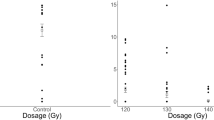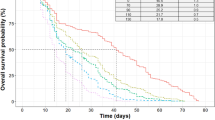Abstract
The sensitivity of the Mediterranean flour moth, Ephestia kuehniella, eggs in different stages of development to gamma irradiation was studied and the acceptability of irradiated eggs by Trichogramma cacoeciae females was examined. Eggs ranging in age from 1–24 to 49–72 h were exposed, at 24 h intervals, to gamma radiation dosages ranging from 25 to 400 Gy and effects of gamma radiation on egg hatch and adult emergence was investigated. In addition, the developmental rate of immature stages (larvae and pupae), resulting from irradiated eggs, to the adult stage was examined and the acceptance of irradiated eggs to T. cacoeciae females was evaluated. Results showed that the radio-sensitivity of E. kuehniella eggs decreased with increasing age. Egg hatch in 1–24-h-old eggs was significantly affected at 25 Gy dose and at 75 Gy dose, no egg hatch was observed. When irradiating 25–48-h-old eggs, however, egg hatch was less than 5% at 100 Gy dose, and eggs 49–72-h-old were more resistant; 50 Gy had no significant effect on egg hatch and 300 Gy did not completely prevent it. Irradiation also negatively affected survival to the adult stage. When 25–48-h-old eggs were irradiated, survival to the adult stage was completely prevented at 75 Gy dose and no survival was observed beyond 100 Gy dose in 49–72-h-old eggs. In addition, the rate of development of immature stages resulting from irradiated eggs was negatively affected. While more than 97% of control moths emerged within 30 days, this ratio decreased to 53 and 69% in 1–24 and 25–48-h-old eggs exposed to 25 Gy dose. Furthermore, irradiation positively affected the degree of acceptance of eggs to parasitization; irradiated eggs (≤49-h-old) were more acceptable to T. cacoeciae than cold-treated ones.

Similar content being viewed by others
References
Al-Motny W (1997) Ecological studies on the woolly apple aphid, Eriosoma lanigerum (Hausmann) in Sweida and Zabadani regions. MSc thesis, Damascus University, Damascus, Syria
Al-Motny W (2003) Evaluation of codling moth, Cydia pomonella (L.), biological control agents in the Sweida area. PhD thesis, Damascus University, Damascus, Syria
Anonymous (2005) Annual agricultural statistics. Ministry of Agriculture Publications, Damascus, Syria
Ayvas A, Tuncbileck AS (2006) Effects of gamma radiation on life stages of the Mediterranean flour moth Ephestia kuehniella Zeller (Lepidoptera: Pyralidae). J Pest Sci 79:215–222
Ayvaz A, Karasu E, Karaborklu S, Tuncbilek AS (2008a) Effects of cold storage, rearing temperature, parasitoid age and irradiation on the performance of Trichogramma evanescens Westwood (Hymenoptera : Trichogrammatidae). J Stored Prod Res 44:232–240
Ayvaz A, Albayrak S, Karaborklu S (2008b) Gamma radiation sensitivity of the eggs, larvae and pupae of Indian meal moth Plodia interpunctella (Hubner) (Lepidoptera: Pyralidae). Pest Manag Sci 64:505–512
Babi A (1990) Bioécologie de Trichogramma cacoeciae Marchal et T. daumalae Dugast & Voegele (Hym. Trichogrammatidae). Utilisation en lutte biologique contre Lobesia botrana Den. & Shiff. (Lep. Tortricidae). Faculté des Sciences et Techniques d’Aix-Marseille, France, 143 pp
Barnay O, Pizzol J, Gertz C, Kienlen JC, Hommay G, Lapehin L (1999) Host density-dependence of discovery and exploitation rates of egg patches of Lobesia botrana (Lepidoptera: Tortricidac) and Ephestia kuehniella (Lepidoptera: Pyralidae) by the parasitoid Trichogramma cacoeciae (Hymenoptera: Trichogrammatidae). J Econ Entomol 92:1311–1320
Breniere J (1965) Les Trichogrammes parasites de Proceras sacchariphagis Boj., borer de la canne a sucre a Madagascar. Troisieme partie: realization de l elevage massal du parasite. Entophaga 10:119–131
Brower JH (1982) Parasitization of irradiated eggs and eggs from irradiated adults of the Indian meal moth (Lepidoptera: Pyralidae) by Trichogramma pretiosum (Hymenoptera: Trichogrammatidae). J Econ Entomol 75:939–944
Calderon M, Navarro S (1971) Effect of UV irradiation on the eggs of Ephestia cautella (WIK) (Lepidoptera: Phyccitidae). J Stored Prod Res 7:309–311
Calvin DD, Losey JE, Knapp MC, Poston FL (1997) Oviposition and development of Trichogramma pretiosum (Hymenoptera: Trichogrammatidae) in three age classes of southwestern corn borer eggs. Environ Entomol 26:385–390
Cross JV, Solomon MG, Babandreier D, Blommers L, Easterbrook MA, Jay CN, Jenser G, Jolly RL, Kuhlmann U, Lilly R, Olivella E, Toepfer S, Vidal S (1999) Biocontrol of pests of apples and pears in northern and central Europe: parasitoids. Biocontrol Sci Tech 9:277–314
Daumal J, Voegele J, Brun P (1975) Trichogramma II—a unit for the mass production on a daily basis of a substitute host Ephestia kuehniella Zell Lepidoptera, Pyralidae). Ann Zool Ecol Anim 7:45–59
Desneux N, Decourtye A, Delpuech JM (2007) The sublethal effects of pesticides on beneficial arthropods. Annu Rev Entomol 52:81–106
Elbadry E (1965) Some gamma radiation effects on host-parasitoid relationships. Ann Entomol Soc Am 58:209–212
El-Wakeil NE (2007) Evaluation of efficiency of Trichogramma evanescens reared on different factitious hosts to control Helicoverpa armigera. J Pest Sci 80:29–34
Fatima B, Ashraf M, Ahmad N, Suleman N (2002) Mass production of Trichogramma chilonis: an economical and advanced technique. In: BCPC conference—pests and diseases, vol 1–2, pp 311–316
Goldstein LF, Burbuits PP, Ward DG (1983) Rearing Trichogramma nubilale (Hymenoptera: Trichogrammatidae) on ultraviolet-irradiated eggs of the European corn borer (Lpidoptera: pyralidae). J Econ Entomol 76:969–971
Haider N, Monge JC, Zebtiz CP (2001) Mechanism regulating the interspecific competition of two symmetrically occurring species of Trichogramma. Egg Parasitoid News 13:10
Hallman G (2000) Expanding radiation quarantine treatments beyond fruit flies. Agr For Entomol 2:85–95
Hooper GHS (1989) The effects of ionizing radiation on reproduction. In: Robinson AS, Hooper G (eds) Fruit flies their biology, natural enemies and control, vol 3. Elsevier, Amsterdam
Ibrahim R, Holst H (2001) Occurrence and distribution of Trichogramma spp. in vine yards. Egg parasitoid News 13:10
Knight AL, Brunner JF, Alston D (1994) Survey of azinophosmethyl resistance in codling moth (Lepidoptera: Tortricidae) in Washington and Utah. J Econ Entomol 87:285–292
Lewis WJ, Young JR (1972) Parasitism by Trichogramma evanescens of eggs from tepa-sterilized and normal Heliothis zea. J Econ Entomol 65:705–708
Makee H, Saour G (2003) Noninherited sterility in irradiated Phthorimaea operculella females. J Appl Entomol 127:489–493
Mansour M (2002) Phenology of the codling moth Cydia pomonel (L.), in the southern part of Syria and its damage to apple fruit. Pol J Entomol 71:79–89
Mansour M (2004) Effects of gamma irradiation on codling moth Cydia pomonella (L.) eggs. J Radiat Phys Chem 71:1125–1128
Marston N, Ertle LR (1969) Host age and parasitism by Trichogramma minutum (Hymenoptera: Trichogrammatidae). Ann Entomol Soc Am 62:1476–1482
Monje JC, Zebitz CPW, Ohnesorge B (1999) Host and host age preference of Trichogramma gallot and T. pretiosum (Hymenoptera: Trichogrammatidae) reared on different hosts. J Econ Entomol 92:97–103
Ozyardimci B, Cetinkaya N, Denli E, Ic E, Alabay M (2006) Inhibition of egg and larval development of the Indian meal moth Plodia interpunctella (Hubner) and almond moth Ephestia cautella (Walker) by gamma radiation in decorticated hazelnuts. J Stored Prod Res 42:183–196
Rothschild GHL (1982) Suppression of mating in the codling moth with synthetic sex pheromones and other compounds. In: Kydonieus AF, Beroza M (eds) Controlled insect suppression with controlled release pheromone systems, vol 2. CRC Press, Boca Raton, FL, pp 117–134
Saour G (2004) Parasitization of potato tuber moth eggs (Lep., Gelechiidae) from irradiated adults by Trichogramma (Hym., Trichogrammatidae) and control of moth population with combined releases of sterile insect and egg parasitoid. J Appl Entomol 128:681–686
Schneider F (1957) Report to the government of Syria on insect pests of fruit trees and some other crop. FAO Rep. No. 664, 20 pp, Rome, Italy
Talhouk A (1954) A list of insects found on plants of economic importance in Syria. Bull Soc Fouad Entomol 38:305–309
Theiling MK, Croft BA (1988) Pesticide side effects on Arthropod natural enemies: a database summary. Agric Ecosyst Environ 21:191–218
Tilton EW, Brower JH (1983) Radiation effects on arthropods. In: Josephson ES, Peterson MS (eds) Preservation of food by ionizing radiation, vol 2. CRC, Boca Raton, FL, pp 269–316
Toba HH, Burditt AK (1992) Gamma irradiation of codling moth (Lepidoptera: Tortricidae) eggs as a quarantine treatment. J Econ Entomol 85:464–467
Varela LG, Welter SC, Jones VP, Brunner JF, Riedl H (1993) Monitoring and characterization of insecticide resistance in codling moth (Lepidoptera: Tortricidae) in our western states. J Econ Entomol 86:1–10
Vieira V, Tavares J (1992) Multiplicacao de Trichogramma cordubensis (Hymenoptera: Trichogrammatidae) usando ovos de Ephestia kuehniella (Lepedoptera: Pyralidae). Boletim Sociedade portuguesa Entomoloia 1:445–452
Vieira V, Tavares J (1995) Rearing of Trichogramma cordubensis (Hymenoptera: Trichogrammatidae) on Mediterranean flour moth cold stored eggs. INRA, Paris (les Colloques, No. 73)
Voegele J, Daumal J, Brun P, Onillon J (1974) The effect of cold storage and UV radiation treatment of the eggs of Ephestia kueheniella (Pyralidae) on the fecundity of Trichogramma evanescens and T. brasiliensis (Hymenoptera: Trichogrammatidae). Entomophage 19:341–348
Welter SC, Varela L, Freeman R (1991) Codling moth resistance to azinphosmethyl in California. Pest Manag Newslett 3:12
White LD, Koslinska M, Suski ZW (1977) Codling moth: field-cage mating competitiveness of radiosterilized males. J Econ Entomol 70:64–69
Witzgall P, Stelinski L, Gut L, Thomson D (2008) Codling moth management and chemical ecology. Annu Rev Entomol 53:503–522
Author information
Authors and Affiliations
Corresponding author
Additional information
Communicated by A. Juen.
Rights and permissions
About this article
Cite this article
Mansour, M. Effects of gamma radiation on the Mediterranean flour moth, Ephestia kuehniella, eggs and acceptability of irradiated eggs by Trichogramma cacoeciae females. J Pest Sci 83, 243–249 (2010). https://doi.org/10.1007/s10340-010-0291-8
Received:
Accepted:
Published:
Issue Date:
DOI: https://doi.org/10.1007/s10340-010-0291-8




